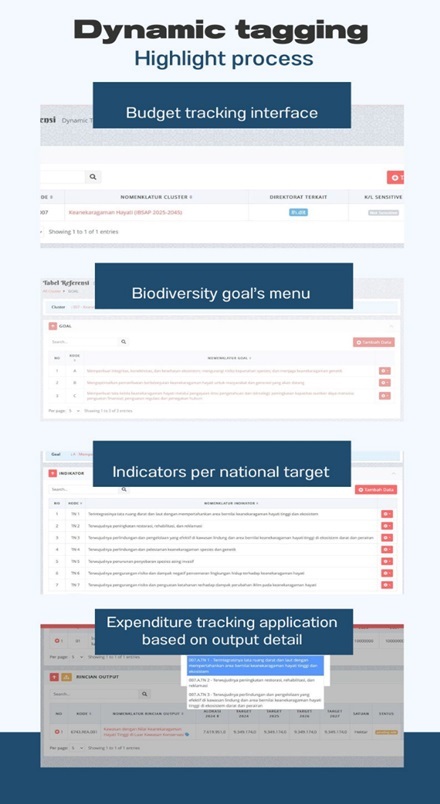
Prepared by Bayuni Shantiko, Programme Manager, BIOFIN Indonesia and Sopian Hidayat, Analyst/Economist, BIOFIN Indonesia
Since biodiversity - unlike agriculture or fisheries - is not an economic sector, the only way to track spending on national targets is to identify which major expenditures have a clear biodiversity conservation target and to tag them. Indonesia has used a system of thematic tagging of budgets for the past 10 years.
Thematic tagging focuses primarily on sectors such as infrastructure, South-South and Triangular Cooperation (SSTC), gender equality measures, climate change mitigation and adaptation, education and health. The data is then consolidated into a common platform called KRISNA, which is operated by the Ministry of Planning and the Ministry of Finance. These tagging systems help to measure progress towards national targets, harmonise spending and improve the effectiveness of spending. Originally, biodiversity was not included – but this has changed with the approval of a new dynamic tagging system.
UNDP-BIOFIN has been supporting biodiversity tracking since 2021 in collaboration with the National Development Planning Agency (Bappenas) through a series of meetings, consultations and coordination between technical departments.
Indonesia's Biodiversity Action Plan 2015-2020 required US$10.6 billion ($1 = Rp 15,853) to manage and improve biodiversity management across the country, given the rich biodiversity that stretches from the mountain ridges to the depths of the oceans. In 2016, the BER identified US$0.41 billion in public funding for biodiversity. This amount has been increased to US$ 0.62 billion by 2022, but there is still a large funding gap. This emphasises the need to improve budget implementation by identifying and targeting public spending relevant to biodiversity.
The change from thematic to dynamic tagging in KRISNA was initiated because biodiversity was not included in the thematic tagging. The introduction of new thematic tag for biodiversity is a lengthy process that requires the approval of several authorities. Dynamic tagging offers several advantages. Firstly, it only requires annual updates by Bappenas. Secondly, it can be introduced at any planning and budgeting stage, which makes it less rigid than thematic tagging. Therefore, dynamic tagging of biodiversity is preferred as it is a more flexible and efficient tool for budget management. In contrast, thematic tagging of biodiversity would require complex institutional arrangements, including regulations that do not currently exist.
Dynamic tagging has already been used for various specific topics such as the National Action Plan for Persons with Disabilities, the SDGs, national economic recovery and several others.
The introduction of the new tagging system will take place in 3 phases: (1) the initial phase (2021-2023), (2) the intermediate phase (2024-2025) and (3) the advanced phase (after 2025). The initial phase was used to establish the definition of biodiversity expenditure, set inclusion/exclusion criteria and indicators, and demonstrate initial biodiversity expenditure based on available data. This process enabled the tagging of US$ 0.59 billion as biodiversity expenditure by 8 ministries in 2023. The main outcome of the first phase was to establish definitions and boundaries for tracking the biodiversity budget, identify parties or associated partners and options for tagging mechanisms.
In the intermediate phase, dynamic tagging is carried out by the Directorate at Bappenas, which manages full access to the budget data. However, the limited human and time resources as well as the legal framework pose a challenge. Therefore, capacity building in the directorate, additional options for system tagging and the creation of guidelines for tagging data are essential prerequisites. Finally, in the advanced phase, tagging of biodiversity budgets is carried out by planning units within ministries or agencies.
Similar to thematic tagging, the process is then reviewed and approved by the partners in the National Development Planning Agency Directorate. Both the line ministries and the partners in the directorates are very familiar with the objectives and outcomes of the activities. They also have full access to data and information pertaining to their respective ministry or agency. To achieve this, additional options for thematic tagging within the system, the development of human resources capacity and the creation of ground rules to enforce thematic tagging are needed.
While a growing number of countries have identified their biodiversity expenditure through one-off measurements, Indonesia is one of the first countries to adopt a more systematic approach.

Categories
Archives
- December 2025 (1)
- November 2025 (5)
- October 2025 (6)
- September 2025 (2)
- August 2025 (10)
- July 2025 (9)
- June 2025 (5)
- May 2025 (8)
- April 2025 (9)
- March 2025 (8)